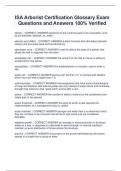Examen
ISA Arborist Certification Glossary Exam Questions and Answers 100% Verified
ISA Arborist Certification Glossary Exam Questions and Answers 100% Verified abiotic: - CORRECT ANSWER-pertaining to the nonliving parts of an ecosystem, such as soil particles, bedrock, air, water. abscisic acid (ABA): - CORRECT ANSWER-a plant hormone that stimulates stomatal closure and pr...
[Montrer plus]



